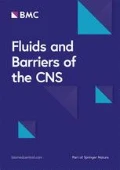Background
We developed a method to measure the en-face surface area of human arachnoid granulations (AGs) on a standardized superior view of the brain. This technique permits the topographical mapping of AG distribution on the surface of the brain. Surface area measurements are correlated with donor age, sex, and race.
Materials and methods
Formalin fixed brains were imaged with a 35 mm Nikon camera set at a fixed distance. Images were segmented and AGs identified in Adobe Photoshop by two independent investigators. Twenty-five fiducial points were identified in a standard method for each cerebral hemisphere, and an average hemisphere template was calculated. Each segmented image was transformed to the standard template; an average hemisphere template was calculated. The transformed images were used to calculate a probability-of-occurrence map that depicts the spatial distribution of AGs. A linear regression was used to assess reproducibility.
Results
Images have been analyzed from 56 brains. Regression analysis confirms reproducibility of AG identification between independent researchers (r2 = 0.98). Topographic probability distribution is primarily along the longitudinal fissure.
Analysis of these brains has revealed an average AG surface area of 75.1 mm2 for age group 38–53 years old, 67.5 mm2 for 54–68, and 82.3 mm2 for > 68. The proportional analysis of AG surface area to total brain surface area indicates a positive relationship with age which was not statistically significant. Total brain surface area broken down by age shows a trend which declines with age.
Analysis also revealed an average AG surface area of 58.9 mm2 for females and 103.5 mm2 males, a difference which was statistically significant. Proportion of positive AG surface area broken down by age and sex indicates that females have a smaller proportion surface area in most age groups. A statistically significant difference in race was also found, with whites having a smaller proportion of positive area compared to African Americans.
Conclusion
The probability-of-occurrence maps, based on the image analysis methods, show that AGs are localized in a characteristic distribution with regions of high and low probability. These measurements provide age-related surface area quantification data as absolute values and proportional area with respect to total brain area. Statistically significant differences in AG surface were found between sex and race. Additional brain specimens will provide greater statistical power for determination of the effects of independent variables such as age, sex, race, height, weight, and BMI on the topographic distribution and quantity of human AGs.
Author information
Authors and Affiliations
Corresponding author
Rights and permissions
Open Access This article is published under license to BioMed Central Ltd. This is an Open Access article is distributed under the terms of the Creative Commons Attribution 2.0 International License (https://creativecommons.org/licenses/by/2.0), which permits unrestricted use, distribution, and reproduction in any medium, provided the original work is properly cited.
About this article
Cite this article
Grzybowski, D.M., Herderick, E.E., Kapoor, K.G. et al. Human arachnoid granulation probability of occurrence and surface area quantification. Fluids Barriers CNS 3 (Suppl 1), S13 (2006). https://doi.org/10.1186/1743-8454-3-S1-S13
Published:
DOI: https://doi.org/10.1186/1743-8454-3-S1-S13

